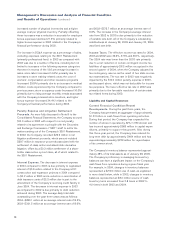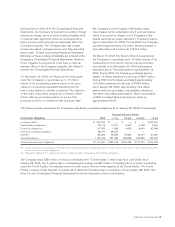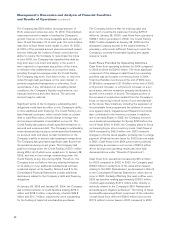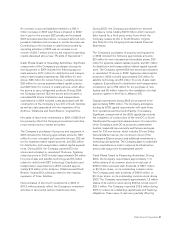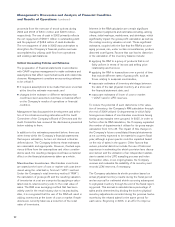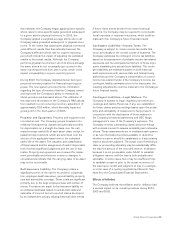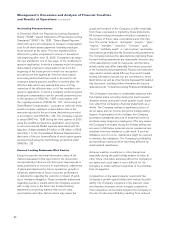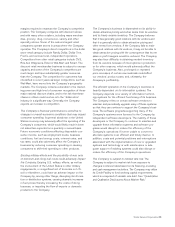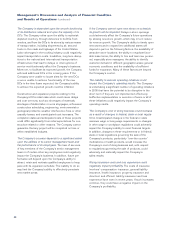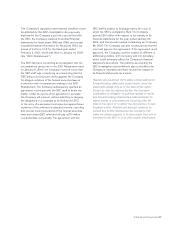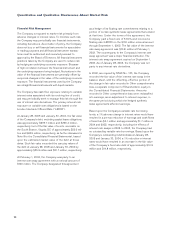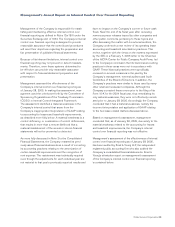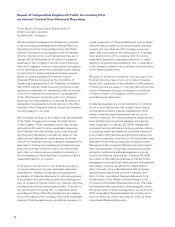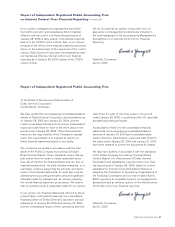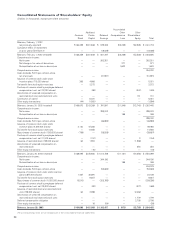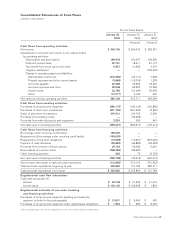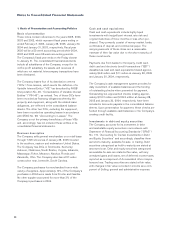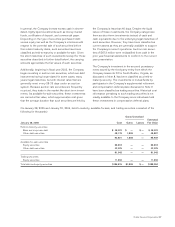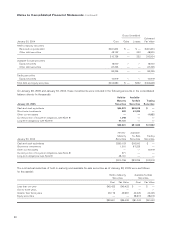Dollar General 2004 Annual Report Download - page 30
Download and view the complete annual report
Please find page 30 of the 2004 Dollar General annual report below. You can navigate through the pages in the report by either clicking on the pages listed below, or by using the keyword search tool below to find specific information within the annual report.28
Quantitative and Qualitative Disclosures About Market Risk
Financial Risk Management
The Company is exposed to market risk primarily from
adverse changes in interest rates. To minimize such risk,
the Company may periodically use financial instruments,
including derivatives. As a matter of policy, the Company
does not buy or sell financial instruments for speculative
or trading purposes and all financial instrument transac-
tions must be authorized and executed pursuant to
approval by the Board of Directors. All financial instrument
positions taken by the Company are used to reduce risk
by hedging an underlying economic exposure. Because
of high correlation between the financial instrument and
the underlying exposure being hedged, fluctuations in the
value of the financial instruments are generally offset by
reciprocal changes in the value of the underlying economic
exposure. The financial instruments used by the Company
are straightforward instruments with liquid markets.
The Company has cash flow exposure relating to variable
interest rates associated with its revolving line of credit,
and may periodically seek to manage this risk through the
use of interest rate derivatives. The primary interest rate
exposure on variable rate obligations is based on the
London Interbank Offered Rate (“LIBOR”).
At January 28, 2005 and January 30, 2004, the fair value
of the Company’s debt, excluding capital lease obligations,
was approximately $278.7 million and $265.4 million,
respectively (net of the fair value of a note receivable on
the South Boston, Virginia DC of approximately $50.0 mil-
lion and $48.9 million, respectively, as further discussed in
Note 8 to the Consolidated Financial Statements), based
upon the estimated market value of the debt at those
dates. Such fair value exceeded the carrying values of
the debt at January 28, 2005 and January 30, 2004 by
approximately $35.5 million and $21.7 million, respectively.
At February 1, 2002, the Company was party to an
interest rate swap agreement with a notional amount of
$100 million. The Company designated this agreement
as a hedge of its floating rate commitments relating to a
portion of certain synthetic lease agreements that existed
at that time. Under the terms of the agreement, the
Company paid a fixed rate of 5.60% and received a
floating rate (LIBOR) on the $100 million notional amount
through September 1, 2002. The fair value of the interest
rate swap agreement was $(2.6) million at February 1,
2002. The counterparty to the Company’s interest rate
swap agreement was a major financial institution. The
interest rate swap agreement expired on September 1,
2002. As of January 28, 2005, the Company was not
party to any interest rate derivatives.
In 2002, as required by SFAS No. 133, the Company
recorded the fair value of the interest rate swap in the
balance sheet, with the offsetting, effective portion of
the change in fair value recorded in Other comprehensive
loss, a separate component of Shareholders’ equity in
the Consolidated Financial Statements. Amounts
recorded in Other comprehensive loss were reclassified
into earnings, as an adjustment to interest expense, in
the same period during which the hedged synthetic
lease agreements affected earnings.
Based upon the Company’s variable rate borrowing
levels, a 1% adverse change in interest rates would have
resulted in a pre-tax reduction of earnings and cash flows
of less than $0.1 million and approximately $1.7 million in
2004 and 2002, respectively, including the effects of
interest rate swaps in 2002. In 2003, the Company had
no outstanding variable rate borrowings. Based upon the
Company’s outstanding indebtedness at January 28,
2005 and January 30, 2004, a 1% reduction in interest
rates would have resulted in an increase in the fair value
of the Company’s fixed rate debt of approximately $10.5
million and $14.8 million, respectively.


